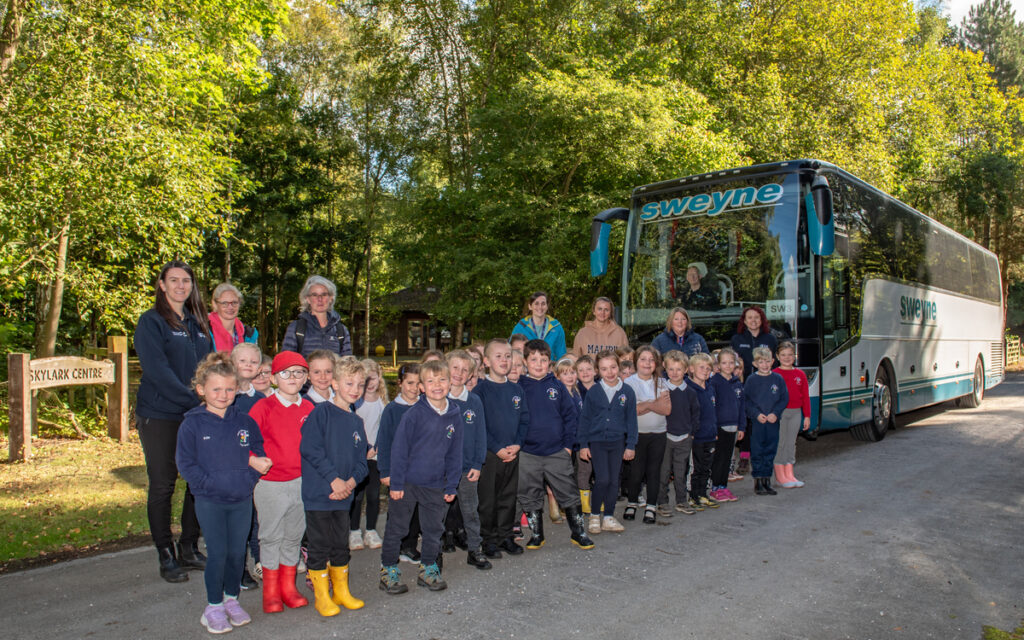Children from the school’s year two class were given free travel and admission to Drax’s Skylark Centre, a nature centre at the Barlow Nature Reserve, which is home to a variety of wildlife including deer, sheep, herons, skylarks and a swan sanctuary. Schoolchildren spent the day learning about wildlife found on the reserve and completed a number of outdoor activities.
The Transport Fund was created in June 2024 to help support young people develop their science technology engineering and maths (STEM) skills. Providing schools meet the qualifying criteria, which includes being sited within 15 miles of a Drax Power Station and having at least 20% of their pupils being on free school meals, they can apply for transport grants of up to £500.
Helen Green, Year 2 Class Teacher, Howden Church of England Infant School said: “What an amazing start to the school year! Our Year 2 children visited the Skylark Centre at Drax to find out about living things in their environment. They made bug hotels, went on a big bug safari and went pond dipping. In the afternoon, they worked as teams to build dens.
“Educationally and socially, it was a wonderful experience for all children. In addition to free entry, we were fortunate enough to be given a transport grant for the trip. All children attended free of charge. The cost of coaches can be prohibitive when organising a school trip and put pressure on families. We greatly appreciated being able to give our children this educational opportunity without the heavy burden of coach fees. I have already enquired about visiting next year and hope that the same opportunity will be available, as it really was a valuable, local visit.”
Jane Breach, UK Community and Education Manager at Drax, said: “We are delighted to provide opportunities for local schools to visit our Skylark Centre at Barlow Nature Reserve. It is important for children of all ages to understand the responsibility we have towards ensuring nature, wildlife and their unique ecosystems can co-exist with energy infrastructure such as Drax Power Station, which helps to keep the lights on for millions of homes and businesses across the UK by generating reliable, renewable power.”
As well as being the home to a large number of endangered and rare species of wildlife, the area is farmed and features a number of rest areas and nature walks. The project for the nature reserve, named Barlow Mound, was conceived in the 1970s as a disposal solution for the by-products created by coal power generation. The site has gone on to provide a thriving natural habitat to be enjoyed by wildlife and local residents alike.
Our Tranport Fund awards grants up to £500 towards the cost of transportation to visit either Drax Power Station, Cruachan Power Station or Tongland Hydro Station. Use this link to check eligibility and to apply to the bursary fund.
ENDS
Media contacts:
Kieran Wilson
E: kieran.wilson@drax.com
T: 07729092807
Editor notes
About Drax
Drax Group’s purpose is to enable a zero carbon, lower cost energy future and in 2019 announced a world-leading ambition to be carbon negative by 2030, using bioenergy with carbon capture and storage (BECCS) technology.
Drax’s around 3,000 employees operate across three principal areas of activity – electricity generation, electricity sales to business customers and compressed wood pellet production and supply to third parties. For more information visit www.drax.com
Power generation:
Drax owns and operates a portfolio of renewable electricity generation assets in England and Scotland. The assets include the UK’s largest power station, based at Selby, North Yorkshire, which supplies five percent of the country’s electricity needs.
Having converted Drax Power Station to use sustainable biomass instead of coal it has become the UK’s biggest renewable power generator and the largest decarbonisation project in Europe. It is also where Drax is piloting the groundbreaking negative emissions technology BECCS within its CCUS (Carbon Capture Utilisation and Storage) Incubation Area.
Its pumped storage, hydro and energy from waste assets in Scotland include Cruachan Power Station – a flexible pumped storage facility within the hollowed-out mountain Ben Cruachan.
The Group also aims to build on its BECCS innovation at Drax Power Station with a target to deliver 4 million tonnes of negative CO2 emissions each year from new-build BECCS outside of the UK by 2030 and is currently developing models for North American and European markets.
Pellet production and supply:
The Group has 19 operational pellet plants and developments with nameplate production capacity of around 5 million tonnes a year.
Drax is targeting 8 million tonnes of production capacity by 2030, which will require the development of over 3 million tonnes of new biomass pellet production capacity. The pellets are produced using materials sourced from sustainably managed working forests and are supplied to third party customers in Europe and Asia for the generation of renewable power.
Drax’s pellet plants supply biomass used at its own power station in North Yorkshire, England to generate flexible, renewable power for the UK’s homes and businesses, and also to customers in Europe and Asia.
Customers:
Drax supplies renewable electricity to UK businesses, offering a range of energy-related services including energy optimisation, as well as electric vehicle strategy and management.
To find out more go to the website www.energy.drax.com




















